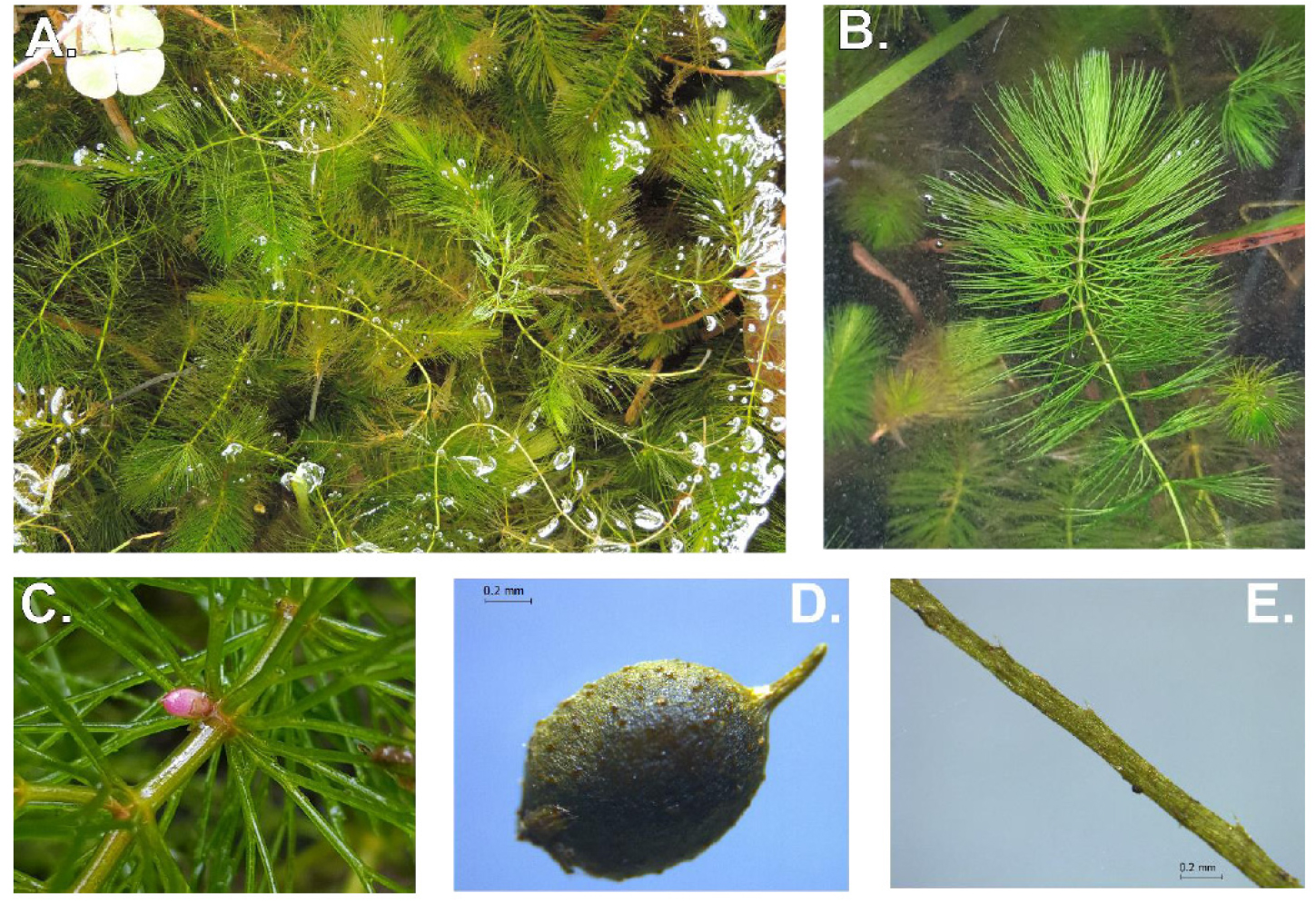Introduction
Ceratophyllum L., the monotypic genus of the family Ceratophyllaceae, is perennial submerged aquatic herbs distributed throughout the world (Les, 1986b; 1988; 1989). The taxonomic position of taxa within the genus has been problematic (Les, 1989; POWO, 2024; Szalontai, 2018; Wilmot-Dear, 1985; Supplementary Table S1). Wilmot-Dear (1985) proposed two species (C. demersum L. and C. submersum L.) and nine varieties (C. demersum var. demersum, C. demersum var. apiculatum (Cham.) Ascherson, C. demersum var. inerme Gay ex Radcliffe-Smith, C. demersum var. platyacanthum (Cham.) Wimmer, C. submersum ssp. submersum var. submersum, C. submersum ssp. submersum var. squamosum Wilmot-Dear, C. submersum ssp. submersum var. haynaldianum (Borbas) Wilmot-Dear, C. submersum ssp. muricatum var. echinatum (A.Gay) Wilmot-Dear, C. submersum ssp. muricatum var. manschuricum Miki) within Ceratophyllum based on fruit and leaf characteristics and geographical distribution. Later, Les (1989) recognized several infraspecific taxa as species and proposed three sections (Sect. Ceratophyllum, Sect. Submersum, Sect. Muricatum) and six species (C. demersum, C. platycanthum Cham., C. submersum, C. echinatum A.Gray, C. muricatum Cham., C. tanaiticum Sapjegin). In recent molecular phylogenetic analyses based on nrITS and cpDNA matK regions (Szalontai, 2018), results indicated that all species proposed by Les (1989) were grouped according to their taxonomic species, except that C. platycanthum was merged into C. demersum var. demersum and C. muricatum ssp. austral was treated as independent species, C. austral Griseb. According to Plants of the World Online (POWO, 2024), Ceratophyllum comprises six species that are same as the species classification proposed by Szalontai (2018). However, several species are classified into infraspecific taxa (especially, C. demersum includes six infraspecifics) (Supplementary Table S1).
Recently, unrecorded plant species continue to be reported in South Korea (Hong et al., 2021; Jang et al., 2022). Until recently, two Ceratophyllum taxa (C. demersum var. demersum and C. demersum var. quadrispinum Makino) have been recognized in the Korea flora (Kim and Choi, 2018; Korea National Arboretum, 2020; National Institute of Biological Resources, 2023). These two taxa share two basal spines on the fruit. However, it can be distinguished by the fact that C. demersum var. demersum does not have a facial spine on the fruit, while C. demersum var. quadrispinum shows two facial spines (Kim and Choi, 2018). During our recent in-depth floristic explorations of Jeju-do, South Korea, an unusual taxon caught our attention. One of the most important diagnostic characteristics of this unrecorded taxon is the absence of the basal spines on fruits. Based on the characteristics of the fruits, the unrecorded taxon was identified as C. demersum var. inerme. In this study, we provide a description and photographs of C. demersum var. inerme, and revised keys to Ceratophyllum taxa in South Korea.
TAXONOMIC TREATMENT
Ceratophyllum demersum var. inerme J. Gay ex Radcl.–Sm. Kew Bull. 37: 609, 1983. –Type: France. Normandy, Pirou, 23 Aug. 1832, Gay, J. E. s.n. (Holotype K, not seen; Isotype G!)
Korean name: 제주붕어마름 (Je-Ju-Bung-Eo-Ma-Reum).
Aquatic perennial herbs. Stems to 1-2 m. Leaves bright or green 8-40 ㎜ long. Leaf blade simple or divided into 2-3(-4) ultimate segments (branched dichotomously once or twice), segments not inflated, 15.1-16.1 ㎜ long, denticles along segment margins conspicuous; leaf whorls 1.5-3 ㎝ in diameter. Fruit brown to reddish brown, body 1.0-4.0 ㎜ x 0.8-3.2 ㎜, not markedly laterally flattened, surface tuberculate to papillate, marginal wing absent, apical spine (persistent style) terete, 0.5-0.7 ㎜ long; facial and basal spines absent (Fig. 1).
Phenology: flowering June to September and fruiting July to October.
Habitat: lakes, ponds, pools.
Distributions: parts of northern Europe, Iraq, Ghana (Wilmot-Dear, 1985), and South Korea.
Specimens examined: Korea. Jeju-do: Jeju-si, Jocheon-eup, Seonheul-ri, 25 Sep. 2022, Lee K.H. s.n. (NNIBR). Jejudo: Jeju-si, Jocheon-eup, Seonheul-ri, 28 Aug. 2023, Choi K.S. s.n. (NNIBR)
Note A newly reported taxon, Ceratophyllum demersum var. inerme, is distributed in parts of northern Europe, Iraq, and Ghana (Wilmot-Dear, 1985) but was firstly identified in Jeju-do, South Korea. C. demersum var. inerme is morphologically similar to the varieties of C. demersum. However, it can be distinguished from other varieties of C. demersum by the absence of basal spines on fruits. Despite the fruit distinctiveness of C. demersum var. inerme, its taxonomic position is contentious. This taxon has been treated as a synonym (Les, 1986a; 1989) or a variety of C. demersum (Radcliffe-Smith, 1983; Wilmot-Dear, 1985; POWO, 2024). A comprehensive evaluation of the systematic position of the taxon, using molecular data, is required. According to our field survey, the natural population of C. demersum var. inerme was found only in Jeju-do, indicating that the distribution area of C. demersum var. inerme is extremely limited. In addition, since it coexists with the endangered plant Dysophylla yatabeana Makino, efforts to conserve its habitat are necessary.
Guidelines for identification of Ceratophyllum taxa in Korea
1. Fruit with two basal spines 2.
2. Fruit without facial spines ꞏꞏꞏꞏꞏꞏꞏꞏꞏꞏꞏꞏꞏꞏꞏꞏꞏꞏꞏꞏꞏꞏꞏꞏꞏꞏꞏꞏC. demersum var. demersum 붕어마름
2. Fruit with two facial spines ꞏꞏꞏꞏꞏꞏꞏꞏꞏꞏꞏꞏꞏ C. demersum var. quadrispinum 오성붕어마름
1. Fruit without basal spines ꞏꞏꞏꞏꞏꞏꞏꞏꞏꞏꞏꞏꞏꞏꞏꞏꞏꞏꞏꞏꞏꞏꞏꞏꞏꞏꞏC. demersum var. inerme 제주붕어마름





